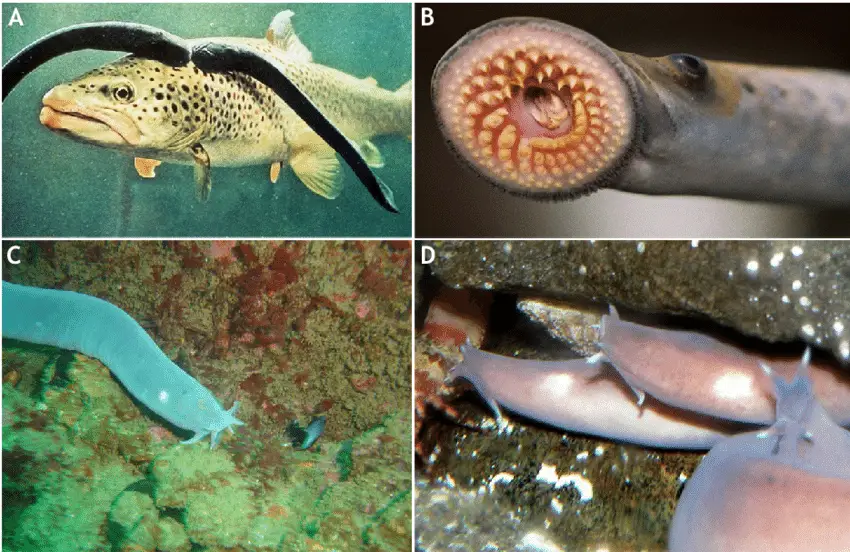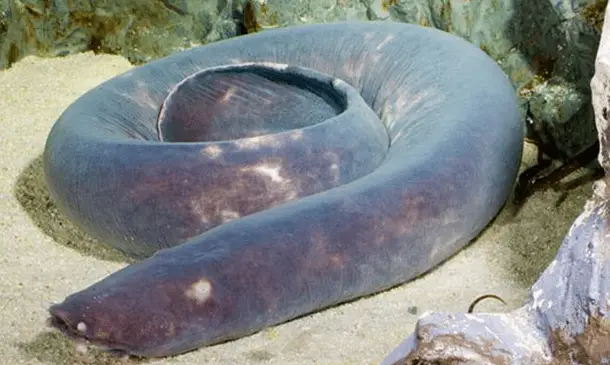Table of Contents
What is Cyclostomata:
Cyclostomata are a group of animals under Group Agatha, members of Cyclostomata do not have jaws. Ostracoderms and Cyclostomata both have jawless mouths do they both are placed under Group Agnatha. The name Cyclostomata refers to the circular jawless mouth of this group of animals, lamprey and Hagfish are examples of this class.
Characteristics Features of Cyclostomata:
Body Shape:
Externally the Cyclostomata closely resemble the eel fish but they are not actually fish, the elongated cylindrical smooth slimy skin gives them an eel fish-like appearance externally.
Fin System:
In Cyclostomata the fin are all unpaired, there are no paired appendages in Cyclostomata. The unpaired median fin is supported by cartilaginous fin rays, the tail has a caudal fin and the caudal fin is diphycercal.

Skin:
In Cyclostomata the skin is smooth and slimy due to the presence of mucous glands present on their skin and the skin is not covered by scales.
Body Parts:
Cyclostomata have a cylindrical head, cylindrical trunk, and tapering post-anal tail.
Segmentation in Muscle:
Like Branchiostoma, Cyclostomata also shows segmentation in the lateral trunk and tail muscle, each segment of muscle is known as myotomes, the myotomes are separated from each other by myocommas.
Jawless Mouth:
The mouth in Cyclostomata is circular and not supported by bony jaw, Ostracoderms also do not have jawed mouths so both Cyclostomata and Ostracoderms are placed under Group Agnatha.
Suctorial Mouth:
The mouth presents ventrally on the anterior side of the head, the mouth has circular muscle which makes their buccal funnel sucking type. The suctorial buccal funnel helps them to attach with the prey fish but in the larval stage, the mouth is not suctorial type. The jawless circular mouth makes them famous as Cyclostomes, in the larval stage, the mouth is bordered by the upper lip and lower lip.

Endoskeleton:
The endoskeleton of Cyclostomata does not have any bony structures, all the endoskeleton are made of cartilaginous tissues. The notochord is the main endoskeletal structure in Cyclostomata, the rod-like notochord is made of cartilage and from outside it is covered by the connective tissue sheath. Over the notochord a remain of rudimentary vertebrae, arcualia present.
Digestive System:
The Petromyzon have a complete digestive tract but there is no stomach in their alimentary canal. The intestine has a longitudinal fold which is known as a spiral valve or typhlosole.
Gill System:
On the lateral side, 5 to 16 pairs of gill are present inside the gill pouches, the gill pouches open externally on the lateral body wall by 1 to 16 pairs of external gill slits. Another name of this class is Marsipobranchi is given due to the presence of a large number of gill in the sac-like gill pouches.
Circulatory System:
In Cyclostomata, the circulatory system has a 2 chambered contractile heart, one auricle, and one ventricle. The heart is enclosed by the thick pericardium, a small conus arteriosus is associated with the heart. Blood has nucleated hemoglobin rich red blood corpuscles and white blood corpuscles, only hepatic portal system present, renal portal system absent.
Excretory System:
The primary excretory organ in Cyclostomata is a pair of mesonephric kidneys, the urine formed in the glomerulus pass into the urinogenital sinus through the ureter then it passes out through the urinogenital papilla.
Nervous System:
The nervous system of the Cyclostomata have a brain with 10 pairs of cranial nerve and the spinal cord gives the peripheral nervous system.
Sense Organs:
Cyclostomata have large-sized two olfactory lobes but the external nostrils are single and median in Cyclostomata present on the head. The auditory organ of the Cyclostomata has an internal ear with one or two vertical semicircular canals.

Reproduction:
Sexes are separate, male and female Cyclostomata produce gametes and release in water, the fertilization occurs externally in water. Gonad is single and does not have gonoduct, the development is direct or indirect with a larval stage of a large time span.
Reference Cyclostomata General Characteristics Features Classifications Systematic Position Affinities
Detailed Study On
Economic Importance of Petromyzon
Nervous System and Excretory System of Petromyzon
Respiratory System and Circulatory System of Petromyzon
Digestive System and Feeding Mechanism of Petromyzon
Anatomy of Petromyzon (Lamprey)
Hi Everyone!!! Welcome to Imaluop. Imaluop always try to learn some new and he want to share to other people. Here we will try to learn various topics on Science, specially on Biological Sciences.